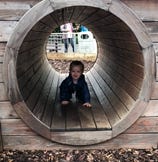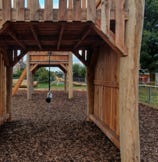Beesmoor


The history of
Beesmoor Road Playing Field
How does £520 buy a playing field?
What was a "beauty and ankle" contest?
If you've got any stories about our history, photos of events, or if you are related to any of the people who helped get us started,
please get in touch on Facebook.
Here historian Ian Haddrell delves into the records
to explain where it all started.



The 1841 Tithe map of Frampton Cotterell (above) identifies what was to become Beesmoor Road Playing Field as plot number 501. The owners of the arable field, ‘Shingles’, were James George and Philip Jones, assignees of the late Henry Davis. The occupier, or person who was renting the land, was a George Thomas, from Iron Acton, who in 1841 was living in Frampton Cotterell with his wife Celia and 10-month-old daughter Hannah.
One hundred years later, the field on the corner of Beesmoor Road and Woodend Road, known at the time as the allotment field, was purchased by Edgar Lewis for £520 at a sale at the Globe Inn on 20 August 1946, on behalf of a number of local subscribers, and was conveyed to four trustees; Tom Hughes, Joseph T. Roach, Gilbert Moseley and Edgar Lewis, on 26 August 1946.
Edgar Lewis was well known locally for running his “Cycle Depot” shop opposite Zion Chapel in Woodend Road, and then the “Frampton Cotterell & Coalpit Heath Car Hire, Service and Cycle Depot” situated at the junction of Woodend Road and Lower Stone Close, known locally as the Hallelujah Spot... perhaps a forerunner of Frampton Garage?


The following month a committee was formed to administer the Frampton Cotterell Recreation Field Fund set up to raise monies to repay the sums loaned by the subscribers. Mr A. Barron volunteered to put the field and hedges in order and Mr. Baker offered his services to put the boundary wall in a good state of repair.
Various fund raising events took place, the most significant being carnivals in 1947 and 1948. Suggested by local showman Mr Henry Rogers (pictured above), the June carnivals lasting four days, included attractions such as; comic football, boxing, ankle and beauty competitions, baby show, fancy dress parade and skittles. The original plan for the field included cricket and football pitches, netball and tennis courts, children’s corner, car park and a village hall. A Recreation Field entertainments committee was set up with Vic Eaves as it secretary. In the summer of 1948 the field was levelled by a bulldozer and sown with grass seed under the supervision of Mr Gilbert T. Baker of Park Farm, the seed given by Mr Alfred Nichols of Oxbridge Farm.


In November 1948 an approach was made by Coalpit Heath Miners Welfare committee with a view to purchasing the Recreation Field, but in May 1950, the final meeting of the Recreation Field committee was held prior to the transfer of the field to Frampton Cotterell Parish Council. A special parish meeting was held in the Council School on Tuesday 15 August 1950 when representatives of all organisations in the village were invited to attend to elect a new management committee. In a ceremony held in the field Ivor Skidmore (chairman of the field committee) presented the deeds to the field to Tom Hughes (chairman of the parish council). Other members of the committee in attendance were: Joe Smith, Joe Roach, Bertram Fowler, Reg French, Phyllis Luton (treasurer), Tom Hughes Fred Adams (assistant treasurer), Norman Biggs (assistant secretary), and Arthur Player (vice-chairman).
Frampton Athletic football club was founded in 1946 and soon adopted Beesmoor Road playing field as their home pitch, beginning a seventy-year association with the ground which continues today. The team was particularly successful in the 1960s, winning the Berkeley Hospital Junior Cup on a number of occasions, the GFA Cup and Champions of the Bristol & District Division 4. The late 1970s and early 1980s also saw the team achieve many successes in both league and cup competitions.


Well into the 1950s the playing field was a popular venue for the annual Frampton Carnival. There was usually a procession around the local streets, led by a vehicle carrying the Carnival Queen and her attendants, which ended its drive in Beesmoor Road playing field. Originally there was an eliminating contest based on photographs submitted, latterly local young ladies sold programmes for the carnival and the one selling the most became Carnival Queen and the runners up became her attendants. Another popular regular feature of the carnival was the children's fancy dress parade.
Today Beesmoor Playing Field is home to several local football teams, fitness classes, many dog walkers, and has a fantastic wooden play area. For more about how you can use the field and pavilion, please follow the links on our home page, or get in touch.
Ian Haddrell is chairman of the Frampton Cotterell Local History Society, which holds monthly talks about local history. You can find out more on Facebook.


Today the Trustees (or Management Committee), are elected annually and consist of up of to seven members of the Parish, with a potential for a further 20 members from organisations from within the Parish.
If you would like to become a Trustee, we are keen to hear from local people with an interest in helping run the Playing Field.
We changed our name to "Beesmoor Road Playing Field" to reflect our location.
The playing field is a registered Charity (Reg No 301534) and as such,
our activities are governed by the Charity Commission.
Please get in touch by email if you want to know more.
Thanks to local businesses who sponsor us:









